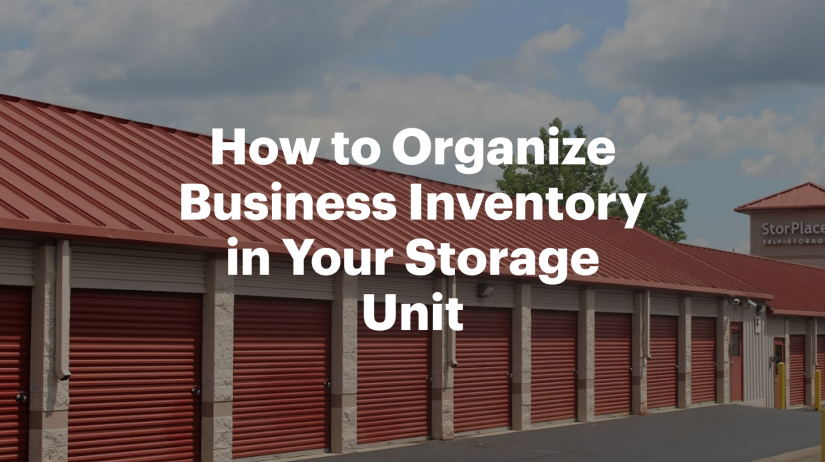How to Organize Business Inventory in Your Storage Unit
When we first started helping business owners organize their storage units here at StorPlace on Rutherford Boulevard, we thought it'd be simple. Throw up some shelves, slap labels on boxes, done.
Organizing business inventory in a storage unit is part science, part trial-and-error. But here's the good news. We've watched dozens of Murfreesboro business owners figure this out, and I'm sharing what actually works.
Why This Matters
We've seen too many businesses treat their storage unit like a black hole where inventory disappears. You need something, can't find it, order more, then discover three months later you had five all along.
That's expensive and completely avoidable.
A disorganized unit costs you time, money from double-ordering, missed sales, and products expiring while buried in the back. Good organization isn't about perfection. It's about creating a system that works for your business.
Step 1: Count Your Inventory First
Before moving anything into your unit, actually count your inventory. Track what you have, dimensions of bulky items, what you access frequently, and what needs climate control.
One boutique owner skipped this and rented a 10x10, then needed a 10x15. Moving everything a month later? Not cheap.
Step 2: Pick the Right Size
5x5: Service businesses with minimal stuff
10x10: Small online sellers, boutiques, trades with seasonal equipment
10x15-10x20: E-commerce doing decent volume, retail overflow, contractors
Our advice? Go one size bigger than you think you need. That extra space lets you organize with aisles instead of playing Tetris every visit.
At our Rutherford Boulevard location, climate control protects inventory from Tennessee's humid summers and cold snaps.
Step 3: Shelving Is Not Optional
If you're storing business inventory without shelving, you're doing it wrong. Full stop.
Purchase industrial metal shelving, priced at approximately $75-$ 150 per unit. Compare that to damaged inventory or hours digging through stacked boxes.
Quick setup:
- 72-inch tall units with adjustable shelves
- 18-24 inch depth
- Place against walls, leave middle open for aisles
- Three 48-inch units fit perfectly in a 10x10
Step 4: Create Zones
Divide your unit into four zones:
Zone 1 (front right): Frequently accessed items, daily movers, best-sellers, go-to tools
Zone 2 (front left): Medium-frequency items you need monthly
Zone 3 (back left): Low-frequency but important old records, rarely-needed equipment
Zone 4 (back right): Miscellaneous, growth space, seasonal overflow
You're just putting frequently-used stuff up front. But naming zones makes the system way easier to maintain.
Step 5: Label Everything
Your labels need:
- What's inside
- Quantity
- SKU or product code
- Date stored
Get a label maker or use thick Sharpie on white labels. Make them readable from across the unit.
One Murfreesboro coffee roaster uses color-coding. Takes him 2 seconds to scan and know his inventory status.
Step 6: Map Your Unit
Draw a simple map showing zones, shelving, and what lives where. Then keep a digital inventory list that references your map:
Use Google Sheets, Sortly, InFlow, whatever works for you. The goal: know what you have and where without driving to your unit.
Step 7: Bins Over Boxes
Cardboard: Fine for archived documents, but they deteriorate and aren't uniform.
Clear plastic bins: You see what's inside, they stack uniformly, they're water-resistant, and they last.
Don't go bigger than a 27-gallon bin for bins you'll move regularly. Your back will thank you.
Step 8: Climate Control for Sensitive Inventory
Tennessee weather is weird. Get climate control if you're storing:
- Electronics, paper products, fabrics, clothing
- Cosmetics, beauty products, and wood furniture
- Anything with adhesive, leather, or photographs
- Food items
The monthly difference at our Rutherford location is reasonable compared to replacing ruined inventory.
Step 9: Schedule Maintenance
Set actual calendar reminders:
Monthly: Full walkthrough, check for issues, verify your system works, rotate stock
Quarterly: Deep clean, reorganize messy categories, update your map
Annually: Conduct an Audit. Count everything, purge non-sellers, reorganize zones
Treat these like business meetings. Because they are.
Step 10: Use FIFO
First-In-First-Out prevents waste. Set up shelves so you load from back, pull from front, like a grocery store.
One Murfreesboro soap maker found 18-month-old soaps buried in her unit. Not sellable anymore. Expensive lesson.
StorPlace Self Storage
Organizing business inventory isn't rocket science, but it requires planning instead of chucking stuff in and hoping for the best.
Start with a plan. Invest in shelving and containers. Create zones. Label obsessively. Maintain your system.
The businesses that succeed with storage treat it like what it is. A legitimate part of operations that deserves attention, like their storefront or website.
Will your first attempt be perfect? Probably not. But you'll figure out what works for your situation and adjust as you go.
Come check us out at StorPlace Self Storage, 2615 S Rutherford Blvd, Murfreesboro, TN 37130. We've got the space, climate control, and honestly, we've seen enough business setups to give you ideas specific to your situation.
Because organized inventory means you can focus on growing your business instead of hunting for products you bought three months ago but can't find.


